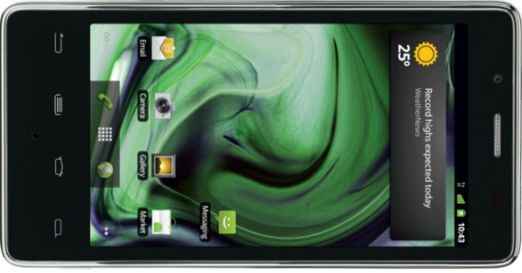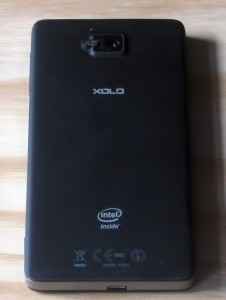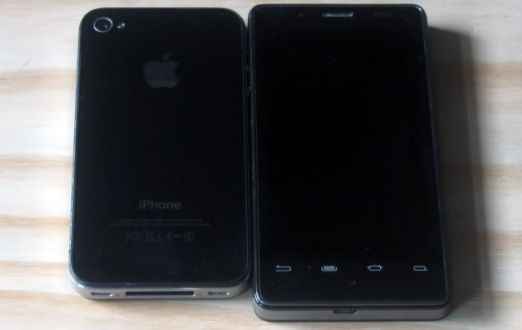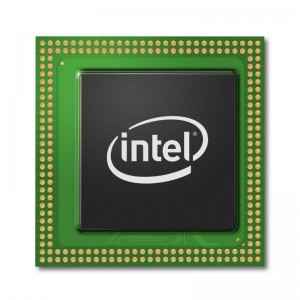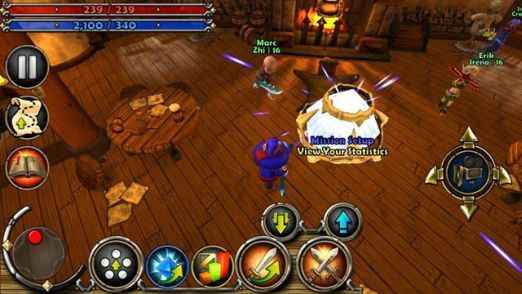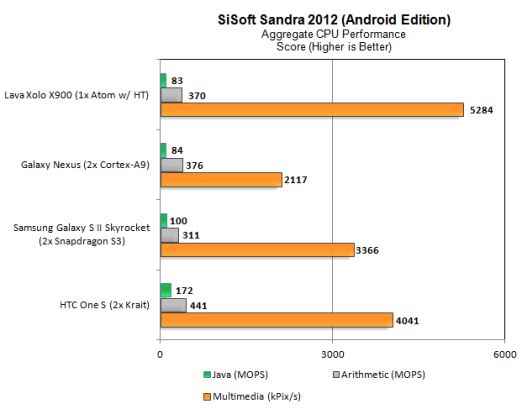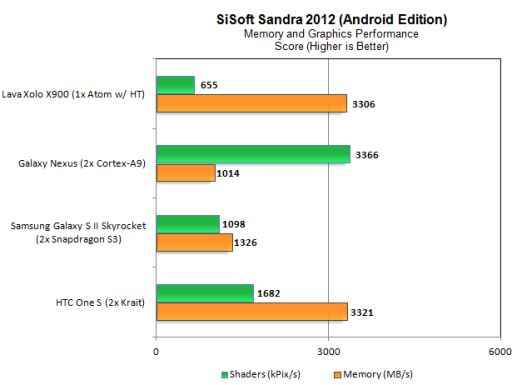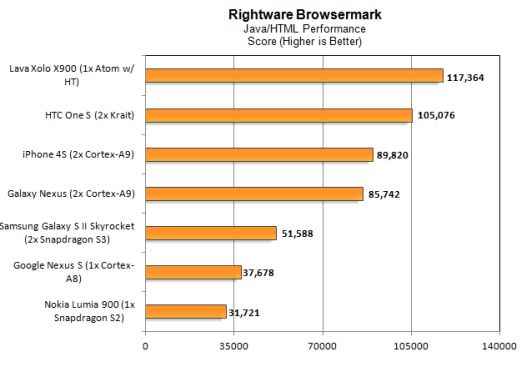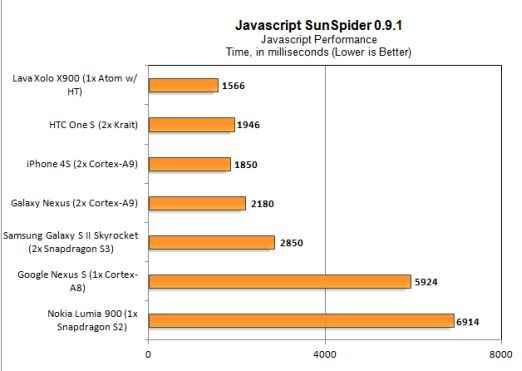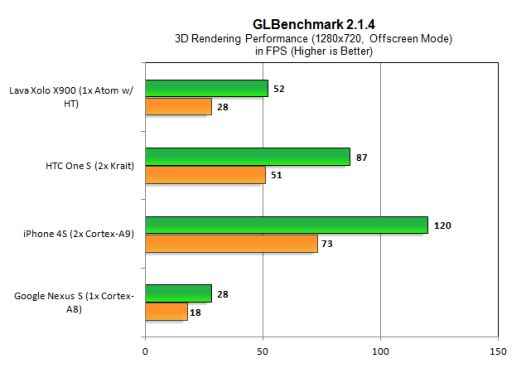Lava’s Intel-based Xolo X900 tested
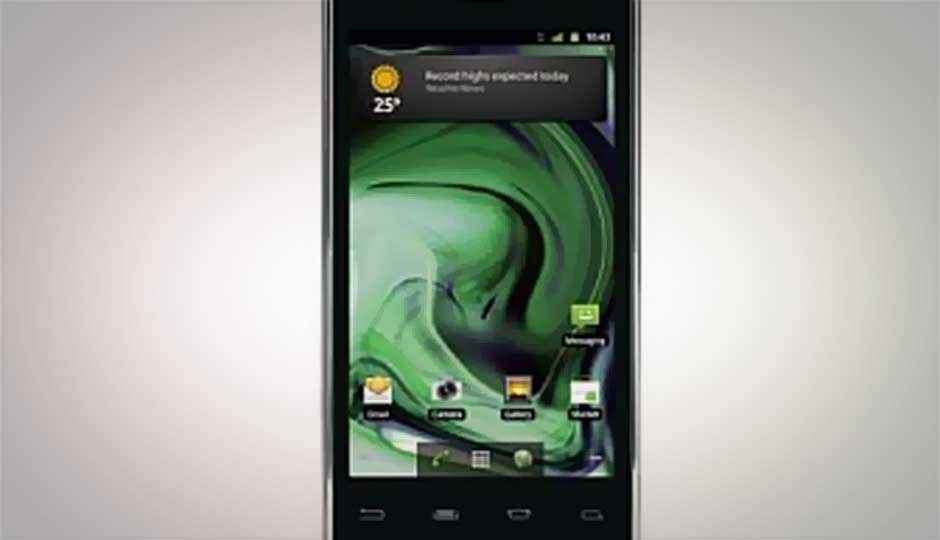
“Intel can’t make smartphones.”
 Survey
SurveyThat statement has summarized the opinion of any number of engineers and business analysts ever since Intel launched Atom back in 2008. The technically oriented have tended to emphasize the larger die and increased power consumption of the x86 instruction set, while business pundits have claimed Intel would fail by refusing to price its parts competitively and accept the lower margins that resulted.
Intel, meanwhile, went ahead and built a smartphone anyway. That device, the Xolo X900, is what we’re reviewing today. It won’t ship to North America — Intel partnered with Indian manufacturer Lava International to bring the product to that country — but this is no prototype or proof-of-concept vehicle.
The Lava Xolo (pronounced ZOH-low) X900 is a 3G (HSPA ) device with a 4-inch 1024×600 screen, 1GB of RAM, a 1.6GHz Atom Z2460 CPU, and an SGX540 GPU clocked at 400MHz. Total available storage is 16GB. It runs Gingerbread (Android 2.3.7) with an upgrade to Ice Cream Sandwich scheduled to drop later this year. The screen is Corning’s Gorilla Glass and the device itself weighs 127 grams, or about 10% less than the iPhone 4S.
The Xolo X900 sports both a front (1.3MP) and rear (8MP) camera, an LED flash, a dedicated camera button, and micro USB / micro HDMI ports. The rear camera is capable of recording in 1080p and supports 1080p H.264 Main Profile playback at 30 fps. The phone’s specs are solid all the way around; easily on par with other shipping Android products.
One of the things I like most about the Xolo is its rubberized back. The oleophobic coating on the iPhone 4/4S may keep nasty grease from building up, but it makes the phone notoriously difficult to hold. The Xolo has an oleophobic coating on the front half (where it matters), and a no-nonsense surface on the back.
Here is the X900 side-by-side with the iPhone 4S. The X900 is slightly larger than the iPhone 4S on all three dimensions, thanks in part to its larger screen. At 1024×600, the Xolo’s screen has a pixel density of about 297 PPI. That’s slightly below the iPhone 4S (330 PPI), but well within the range of what’s considered a “Retina Display.”
First impressions
I recently upgraded to an iPhone 4S after my iPhone 3G took an unfortunate tumble. Up until now, my regular smartphone usage was always with an Apple product. When the X900 showed up on my doorstep I swapped out my SIM card, shifted some music and videos over, and set out to use the Xolo the same way I use my iPhone 4S.
If it weren’t for the Intel logo on the back of the phone there would be no way to know that it’s powered by an x86 processor. Battery life is acceptable — it’s on par with the iPhone 4S, with the caveat that I’m personally not overly thrilled with the battery life of the 4S. (More on this later.) Responsiveness when browsing the web is excellent, as is video playback. The phone has no trouble with Main Profile H.264 video at 30 fps.
Audio quality is good, though the external speakers distort a bit at full volume. This was never actually a problem; the phone’s output is more than sufficient for listening to music or watching video without pushing the volume to 100%. There’s only one audio issue that irritated me, and it may very well be an Android/Gingerbread problem rather than an Intel one. The iPhone can play two distinct sounds at the same time. If you’re listening to music and receive a text message, the phone plays the text message notification (if you have one) without pausing the audio. The X900 doesn’t do this. When a text or IM comes in, it briefly locks out whatever you were listening to or watching at the time.
Game performance is the only area where the X900 sags compared to the iPhone 4S, and we knew that going in. Intel’s Atom Z2640 uses an integrated SGX540 GPU clocked at 400MHz. That’s significantly faster than the majority of SGX540 designs on the market today, but it’s still a single-core solution going up against one of the fastest gaming smartphones available today.
Dungeon Defenders is a bit much for the X900
The size of the gap between the two phones also depends on what sort of game you’re playing. Angry Birds Space, for example, plays perfectly smoothly on both. Dungeon Defenders — an Xbox Live game that debuted on tablets late last year — runs unacceptably slowly, even with all the detail levels turned to minimum. Casual/puzzle fans won’t have a problem.
Simply comparing the list of available titles, however, doesn’t quite guarantee compatibility. In a few cases we ran into apps that were listed in the Xolo’s App Store, but refused to run when we tried to launch them. This, however, was the exception, not the rule. The vast majority of applications and games were listed in both stores and ran on both devices. While there will likely be some prominent programs that slip through the cracks at first, we expect such issues to be fully rectified before x86 Android phones start shipping to North America.
Performance
There’s been a great deal of debate in technical circles over whether or not a single-core x86 Atom with Hyper-Threading could outperform the various dual-core ARM Cortex-A9 solutions on the market — to say nothing of the Snapdragon S4 (Krait) processors Qualcomm is now shipping. We’ve compared the Xolo X900 against a number of ARM devices, with interesting results.
We’d like to particularly thank Adrian Silasi, the developer of SiSoft Sandra, for his work in porting Sandra to the Android operating system. The current version of “Sandroid” (2012.1.18.38) supports both SSE2 and NEON and is capable of testing CPU, GPU, and storage subsystem performance.
While Sandra remains a synthetic benchmark, we’ve worked with and known Adrian for a number of years and trust him when it comes to building programs that will accurately test the relative performance of multiple architectures. We tested the Intel X900 against an HTC One S (dual-core Krait @ 1.5GHz), a Skyrocket S II (dual-core Cortex-A9 @ 1.5GHz) and a Galaxy Nexus (dual-core Cortex-A9 @ 1.2GHz). The Skyrocket S2 is running a custom ICS ROM, which may account for a touch of oddness in the arithmetic and multimedia tests.
We didn’t expect to see the Skyrocket II and Galaxy Nexus swapping spots the way they do, but as one reader noted, the Snapdragon S3 apparently isn’t terribly consistent when matched up against the Cortex-A9. In arithmetic code, Medfield is well-matched against its Cortex-A9 competitors. The Snapdragon S4 is a full 17% faster than the Galaxy Nexus and 20% faster than the Lava Xolo. In multimedia data sets, where Medfield can leverage SSE2, it takes a substantial lead, though Krait’s performance is still excellent. The Snapdragon S4 takes revenge in the Java multimedia test: it’s 72% faster than the Skyrocket II and twice as fast as Intel’s Atom or the Galaxy Nexus.
One thing both the HTC One S and the Lava X900 have in common is substantially better memory bandwidth. Both of the Samsung phones falter here. One interesting result of grouping the GPU and memory bandwidth data together is that it shows that having one doesn’t necessarily boost the other. This is rather different than in the PC world, where low memory bandwidth will kneecap an otherwise powerful GPU.
Next, we’ve got performance in Antutu; a synthetic benchmark favored by the folks at PC Magazine. Here’s the overall performance of a wider range of phones, including the just-launched Lumia 900.
Not much to see here. All of our devices end up within a few hundred points from each other save for the poor Lumia 900. We feel obliged to note that this is an instance where benchmarks really don’t tell you everything — the Lumia’s performance is better than its standing in some of these benchmarks would otherwise indicate.
Next step, browser-based testing.
BrowserMark
BrowserMark is a synthetic HTML/JavaScript rendering test, but it’s a bit less synthetic than tests like SunSpider. Browser choice definitely makes a difference in Rightware’s benchmark; we’ve tested all of the devices here using the browsers they shipped with by default. Android version also makes a difference; some of the devices shown below would undoubtedly speed up if moved to Ice Cream Sandwich rather than stale Gingerbread.
Medfield takes home the bacon here, even against the Snapdragon S4 running Ice Cream Sandwich.
Next up is SunSpider 0.9.1. This JavaScript benchmark was a strong win for Intel back in December and that hasn’t changed much. Even the HTC One S and Galaxy Nexus, both of which run Ice Cream Sandwich, are well behind the Xolo X900 here.
Finally, there’s 3D performance. As we’ve previously noted, this is the Xolo’s one weak spot — GLBenchmark shows the chip’s limitations.
The Xolo is much faster than the 18-month-old Nexus S but fades badly compared to the iPhone 4S or HTC One S. For simple games, the Xolo X900 is going to be fine.
Next page: Cameras, battery life, and wrapping up…
Finally, there’s the camera. Intel put a lot of work into the X900′s camera capabilities and it shows: the Camera application offers a full suite of options to equal those found on a decent point-and-click. The Xolo’s other claim to fame is its “Burst Mode;” the X900 can shoot up to 10 images at 15 frames per second. The burst mode impressed us when we saw the prototypes back in December; particularly when compared to other phones. With some devices, there’s a 1-2 second lag between mode selection and actual image capture, with 1-1.5 seconds in between each photo.
The X900 is a huge step forward in this regard. It doesn’t take pictures quite as quickly as the iPhone 4S, but both cameras are capable of capturing vehicles moving at moderate speed. Comparative image quality, it turns out, is a tougher nut for Intel to crack. The top image is the Xolo, the bottom is the iPhone 4S.
Unfortunately, the weather has been nasty for much of the past week (yes, that’s snow on the ground in late April). The image produced by the iPhone 4S is inarguably prettier, but it doesn’t actually capture what the world looked like. According to the iPhone, I snapped this image on a bright-but-overcast day at the end of a storm. The Xolo, on the other hand, paints the scene in dull, muted shades. It looks bleak and inhospitable, which makes sense — it was sleeting at the time and I was miserably wet.
The iPhone still paints the day in a vibrant palette that doesn’t reflect prevailing weather very well, but the Xolo’s version is too drab. Intel may have done a lot of work on the camera software, but whatever hardware Lava is using isn’t very good.
I don’t have an iPhone equivalent of the next photo; I snapped it at random while walking the dogs. In sunlight, the Xolo’s shortcomings are much less apparent. It’s acceptable, but not much more than that.
The iPhone 4S doesn’t quite get the red of the barn, but the Xolo makes it look brown. Musings on the need to capture the true feeling of a moment aside, the Xolo X900′s camera has too many flaws to recommend it. It’s quick and responsive, nearly equaling the shutter speed of the iPhone 4S and offering a great deal more flexibility, but the quality of the images it produces kneecaps any claim to fame it might have made.
Battery life
One of the downsides to living in rural New York State is that 3G coverage is hard to come by. As a result, our talk-time tests were done on AT&T’s 2G network. One of the most common arguments against an x86 cell phone is the idea that it would draw too much power to be useful. In our tests, however, the Xolo actually beat the iPhone 4S, turning in 13 hours and 15 minutes of talk time against the iPhone 4′s 11 hours. WiFi was disabled on both devices.
While 3G talk times will undoubtedly be shorter, it’s the radio’s operational mode that makes the difference — not the CPU. This suggests that the Xolo X900 should be well matched against the iPhone 4S on a 3G network as well.
HD video playback isn’t quite so rosy. We encoded a number of television shows using the iPhone 4 preset in Handbrake 0.9.6, then looped them and measured how long it took the battery to die. Where the iPhone 4S manages a thoroughly respectable nine hours, Medfield struggles to reach a little more than half of that. This is a weak spot for the phone, particularly considering that Medfield and the iPhone 4S probably use the same hardware from Imagination Technologies (VXD 385 for decode, VXE 285 for encode).
Intel’s history of close collaboration with Imagination Technologies, combined with its own graphics research, suggest that this is a deficit the company will address in future product revisions. For now, however, the iPhone 4S has a clear advantage. The one bright spot to the HD battery life results is that 5 hours of video is enough to keep you distracted through everything but international flights.
Time to start the countdown
The X900 is a solid, well-built Android phone, period. The reason it’s not coming to North America isn’t because it can’t compete, but because (in my opinion) the US market is eternally fixated on flagship devices that often reign for weeks before being deposed by a new model with marginally better features and a catchy name. Medfield isn’t ready to take on the iPhone 4S, and carriers are going to be gun-shy until Intel has a device they believe could challenge Apple.
The major ARM developers like Samsung, Qualcomm, Nvidia, and Texas Instruments don’t have anything to worry about in 2012, but 2013 will be a different story. With the Xolo X900, Intel has officially put the ARM manufacturers on notice. Intel is going to power smartphones, and it’s going to be competitive in that space. For now, that means a handful of solid phones in foreign markets. 12-15 months from now, it’s going to mean design wins on US soil. The Xolo X900′s weak points are addressable. As a first-generation product, it’s downright impressive.
The ARM vendors who take Intel seriously will be the ones who survive. Anyone sitting back and pretending x86 is incapable of performing in this space probably won’t. Competing effectively with Intel in this space is going to take an unusual degree of collaboration between foundries and SoC designers, and it’s not going to happen overnight. We’ve talked before on how companies like Nvidia have been putting pressure on TSMC to improve collaboration and share risk; those are the sorts of changes that need to happen if ARM vendors want to keep their market share.
